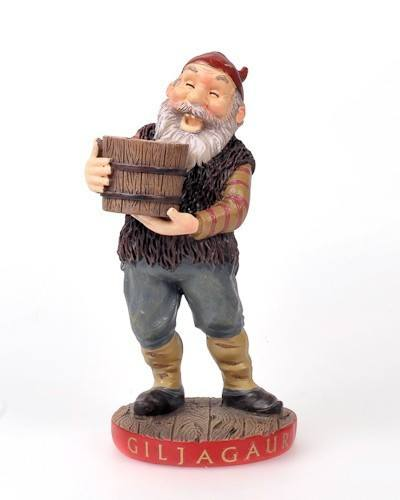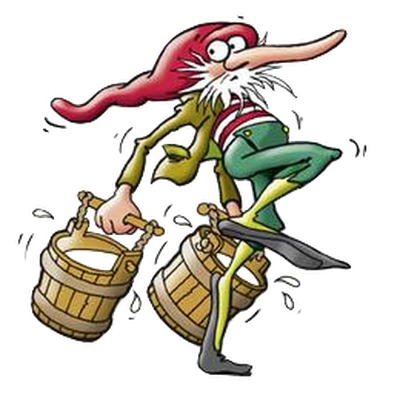
Hopefully you already saw yesterday’s post with an overview of the Icelandic tradition of the Yule Lads. If you haven’t, go back and read that first so this will make more sense. According to folklore, today — December 13 — is the day when the second Yule Lad arrives.
The second Yule Lad’s name is Giljagaur, which translates as Gully Gawk. “His particular brand of mischief involves harassing sheep, but he is ultimately stopped by his stiff peg-legs.”Hides in gullies, waiting for an opportunity to sneak into the cowshed and steal milk.”

Here’s how he’s described in the 1932 Icelandic poem, “Yule Lads,” by Jóhannes úr Kötlum:
The second was Gully Gawk,
gray his head and mien.
He snuck into the cow barn
from his craggy ravine.
Hiding in the stalls,
he would steal the milk, while
the milkmaid gave the cowherd
a meaningful smile.
Gully Gawk arrives each year on December 13, and leaves again on Boxing Day, December 26.

And here’s a more thorough explanation, by Robert Nelson, on Medium.
Giljagaur isn’t the only peeper, as we will come to find out later. His particular form of troublemaking is to hide in the “gullies” or the ravines that carve the landscape of Icelandic farms, and wait for an opportune moment to steal into the cowshed and slurp the foam off the top of the milk bucket.
He is also a continuation of the theme that Stekkjarstaur first introduced us to…barnyard milk thieves. Whereas Stekkjarstaur prefers the company of sheep, Giljagaur opts for the relatively more rare milk from cows.
Sheep are the classic Icelandic herd animals. They were brought in the middle ages and continue to visibly dot the Icelandic countryside, and réttir is still a nationally recognized festival where shepherds on horseback (or in an SUV) will head out to the countryside to retrieve their sheep and bring them back to pasture. Cows, on the other hand, were a luxury for the few wealthy kulaks.
Hálldor Laxness, in his seminal Independent People, describes the conflict between husband and wife over whether to buy a cow. Bjartur, the practical and frugal husband, finds the very idea ridiculous, while his new wife Rósa dreams of the comfort a cow might provide.

And here’s another, from Iceland24:
Gully Imp was the second,
With his grey old head.
He crept down from the mountain,
and into the cow shed.He hid in the stables
– And stole the froth,
While the milkmaid chatted
Up the stable boy.Giljagaur arrives on Dec 13. His name means “Gully Oaf.” He is usually portrayed with gray hair and wearing very plain colored clothes. As his name implies, he hides in the gullies and ditches and canyons near farmsteads. Then, after the cows have been milked, he sneaks into the barn and skims the rich cream from the top of the milk buckets. He hides again and, after morning milking, sneaks back for another creamy snack.
Sometimes his job is very easy to do, especially if you have young dairymaids and handsome warriors and lots of Viking hormones on hand. Giljagaur waits till the flirting gets started, the young people get distracted, and then he runs in and steals the cream.
He also has a fondness for cows, too. And he speaks bovinese, so he and Búkolla here are swapping some stories. Icelandic cows are a special breed, unchanged since the Vikings brought them to the island. They are quite small and can live in mountainous areas, but they are sweet natured and provide a lot of good quality milk. They also come in an amazing variety of colors, and some even have brindle stripes!
Vikings rarely drank milk. They used it for baking and to make other products that kept well in storage, like cheese, sour milk (tastes like buttermilk) and a thick low-fat curd called “skyr.” They also used the whey from cheesemaking as a way to preserve meat products, a tradition that continues to this day in Iceland. The resulting “pickled” meats were an unpleasant grey in color, but they kept well, tasted quite all right, and were nutritious. The whey itself actually has a taste similar to white wine.
The people of Berk managed to always keep a few cows on hand, but they had to hide them in caves and canyons and then make a difficult trek twice a day to milk them. Now, the dragons know to leave cows alone (a few dragons even like cheese as a treat), so once again Giljagaur can raid the stables.
So, keep your fresh cream locked away and make sure that the dairy personnel who work between Dec 13 and 26 are not the kind to be easily impressed by a well turned out pair of biceps.

The 13 Yule Lads, Mom, Dad and Cat:

